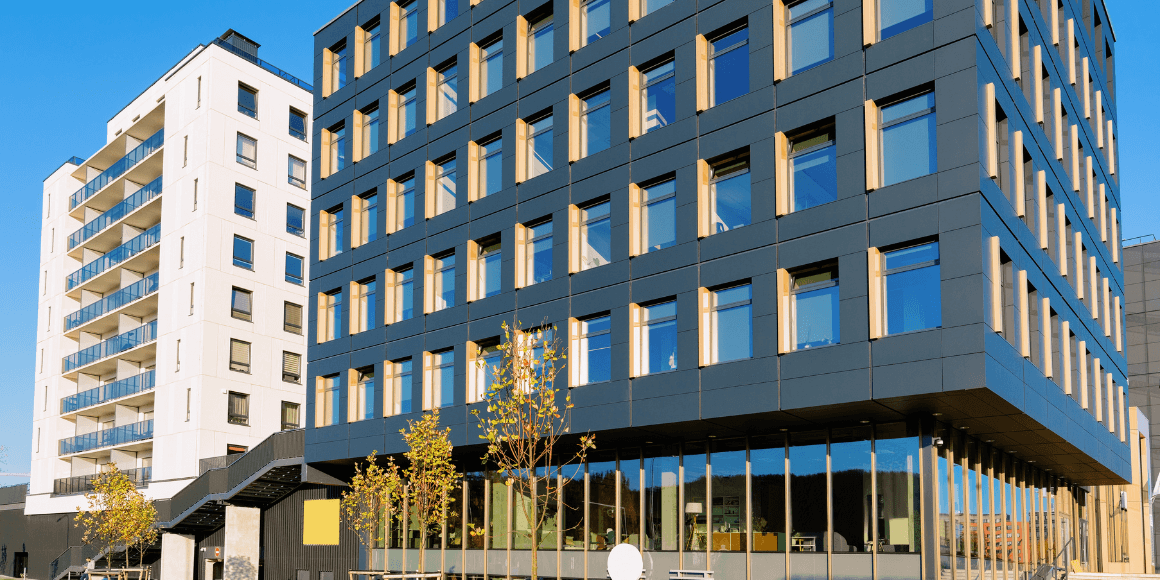
Are you looking to help address our nation’s housing crisis? Learn why commercial-to-residential conversions are gaining popularity and how you can enhance your project through energy efficiency upgrades that contribute to lower utility costs for residents and a more sustainable future.
A Tale of Two Trends
Converting commercial buildings into residential isn’t a brand new concept, but it’s becoming increasingly common due to two key trends:
A Decline in Demand for Commercial Office Space
One of the most notable societal impacts of the pandemic was a shift to a hybrid work world. With office attendance remaining 30 percent lower than it was before the pandemic, many companies have reduced their office space. Prior to the pandemic, we saw a positive absorption rate in the U.S. office real estate leasing market, meaning there was far more office space being newly occupied than vacated. Since the pandemic began, we’ve seen the opposite: Each year sees more space being vacated than newly occupied. As of the fourth quarter of 2023, nearly 17 percent of American office space was vacant.
Offices aren’t the only commercial spaces left vacant in the wake of the pandemic. With more activities (like shopping) moving online, many brick-and-mortar facilities have closed.
A Rising Demand for Housing
In contrast to the declining demand for commercial office space is the steadily rising demand for residential space. The U.S. is experiencing a housing shortage overall and an even more significant shortage of affordable homes, which has prompted many construction companies and real estate investors to focus on building multifamily rental properties. In 2022, multifamily projects constituted over one-third of all housing starts. Despite economic factors like rising interest rates, as more households are being established, this red-hot housing market is not expected to cool off any time soon.
Addressing Both Trends by Converting Commercial to Residential
The first trend we looked at above can actually help us address the second trend. Commercial spaces (such as offices) that now sit vacant can be transformed into valuable residential square footage in cities across the U.S.
This approach is inherently more efficient than demolishing commercial buildings and constructing new residential buildings from the ground up—in terms of time, money, and the environment. Estimates suggest rehabilitated structures can produce 50 to 75 percent fewer carbon emissions than new construction.
The White House even acknowledged this trend in the fall of 2023, commenting, “Facilities with the appropriate building, land-use, and economic characteristics can provide a new source of housing where it is badly needed, and the adaptive re-use of these properties can have the added benefits of improving the efficiency and reducing the emissions of existing buildings.”
Going Green When Converting Commercial to Residential
As investors take on these conversions, they should not only consider the renovations needed to turn these commercial spaces into multifamily housing but also consider ways to make these buildings as energy-efficient as possible.
As the U.S. Department of Energy points out, reducing wasted energy and utilities in your multifamily units offers some valuable benefits:
- Lower operating costs
- Higher property value
- Increased occupant comfort
- Lower cost of living for residents (an important selling point)
With tax incentives to help you make this goal a reality, seizing opportunities for energy efficiency should be a no-brainer.
Energy-Efficiency Upgrades to Implement
As investors look for ways to improve their commercial-turned-residential properties’ energy efficiency, they should consider a variety of potential solutions. Let’s look at a few of the most impactful upgrades you can make.
Opt for energy-efficient lighting.
The fluorescent lighting found in many commercial properties may be more efficient than incandescent lighting, but it falls short of LED lighting. In fact, a University of Michigan research study found that LED lighting is up to 44 percent more efficient than 4-foot fluorescent tubes in linear recessed lighting systems. Upgrading lighting throughout the building can make a notable impact on your and your tenants’ energy costs.
Implement water-saving technologies.
Multifamily units can use a significant amount of water. Implementing water-saving technologies and practices can help you reduce water waste and promote sustainability. For example, you can install low-flow toilets, aerators on faucets, and efficient irrigation systems for landscaping. You can even capture rainwater for non-potable uses such as irrigation or toilet flushing to further reduce reliance on municipal water supplies.
Reinforce your building envelope.
Your building envelope can either help you maintain comfortable temperatures indoors or can let in heat and cold, putting undue pressure on your HVAC system. One easily overlooked but critical area to address is your building’s windows. Residents in your new multifamily unit may love the large windows that characterize many commercial properties, as they let in natural light and help residents feel connected to the environment. However, these windows can also drive up the energy demand for keeping your building comfortable.
One easy solution you can implement to instantly lower cooling costs and improve occupant comfort is window film. Solar window films filter out UV light and reject heat, keeping apartments comfortable—even without help from shades or curtains. You can also use one-way window film (which appears reflective from the outside but completely transparent on the inside) to provide more privacy for ground-floor units.
Make the Most of Your Commercial-to-Residential Conversion Project
The conversion of commercial buildings into residential spaces presents a promising solution to both the surplus of vacant commercial properties and the escalating demand for housing. This transition not only maximizes existing infrastructure but also aligns with sustainability goals, offering a more efficient alternative to new construction—especially when investors seize the opportunity to implement energy-efficiency upgrades.
A partner in commercial building sustainability can help you uncover efficiency opportunities in your specific commercial-to-residential conversion project so you make the most of your real estate conversion project. Take a moment to learn more about Commercial Building Sustainability solutions from NGS!





